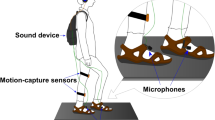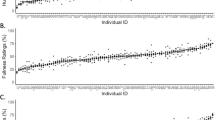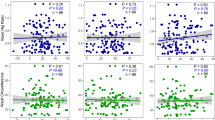Abstract
Objective: Visual analogue scales are widely used in appetite research, yet the validity of these scales to evaluate appetite and mood has not been assessed in older subjects. The aim of this study was to determine the relations between food intake and visual analogue scale (VAS) ratings of appetite and nonappetite sensations in healthy older and young subjects.
Design: Retrospective combined analysis of four single-blind, randomised, controlled appetite studies.
Setting: All studies were conducted in the University of Adelaide, Department of Medicine, Adelaide, Australia.
Subjects: A total of 45 healthy young men (n=24) and women (n=21) aged 18–35 y and 45 healthy older men (n=24) and women (n=21) aged 65–85 y were recruited by advertisement.
Interventions: Oral, intraduodenal or intravenous administration of treatments which suppressed food intake were compared to control. Up to 90 min after treatment, a test meal was offered and subjects ate freely for between 30 and 60 min. Perceptions were assessed by 100-mm visual analogue scales administered at regular intervals.
Results: Food intake at the test meal was positively related to perceptions of hunger, drowsiness, and calmness at both baseline and premeal (r>0.16, P<0.05), and inversely related to premeal ratings of fullness (r> 0.2, P<0.05) in both older and young subjects. Food intake was related to VAS ratings at least as strongly, if not more so, in older as in young subjects.
Conclusions: These observations (i) confirm that food intake is related to perceptions of hunger and fullness as assessed by VAS in healthy older and young subjects, and (ii) suggest that sensations, not obviously associated with appetite, including ‘drowsiness’ and ‘calmness’, are also associated with food intake.
This is a preview of subscription content, access via your institution
Access options
Subscribe to this journal
Receive 12 print issues and online access
$259.00 per year
only $21.58 per issue
Buy this article
- Purchase on Springer Link
- Instant access to full article PDF
Prices may be subject to local taxes which are calculated during checkout
Similar content being viewed by others
References
Andrews JM, Doran SM, Hebbard GS, Rassias G, Sun WM & Horowitz M (1998): Effect of glucose supplementation on appetite and the pyloric motor response to intraduodenal glucose and lipid. Am. J. Physiol. 274, G645–G652.
Christensen L (1993): Effects of eating behaviour on mood: a review of the literature. Int. J. Eat. Disord. 14, 171–183.
Clarkston WK, Pantano MM, Morley JE, Horowitz M, Littlefield JM & Burton FR (1997): Evidence for the anorexia of aging: gastrointestinal transit and hunger in healthy elderly versus young adults. Am. J. Physiol. 272, R243–R248.
Cook CG, Andrews JM, Jones KL, Wittert GA, Chapman IM, Morley JE & Horowitz M (1997): Effects of small intestinal nutrient infusion on appetite and pyloric motility are modified by age. Am. J. Physiol. 273:R755–R761.
de Castro JM (1987): Macronutrient relationships with meal patterns and mood in the spontaneous feeding behavior of humans. Physiol. Behav. 39, 561–569.
Flint A, Raben A, Blundell JE & Astrup A (2000): Reproducibility, power, and validity of visual analogue scales in assessment of appetite sensations in single test meal studies. Int. J. Obes. Relat. Metab. Disord. 24, 38–48.
Folstein MF, Folstein S & McHuth PR (1975): Mini-Mental State: a practical method for grading the cognitive state of patients for the clinician. J. Psychiatr. Res. 12, 189–198.
Fried LP, Kronmal RA, Newman AB, Bild DE, Mittelmark MB, Polak JF, Robbins JA & Gardin JM (1998): Risk factors for 5-year mortality in older adults. The cardiovascular health study. JAMA 279, 585–592.
Horowitz M, Maddern GJ, Chatterton BE, Collins PJ, Harding PE & Shearman PJ (1984): Changes in gastric emptying rates with age. Clin. Sci. 67, 213–218.
Kopelman PG (2000): Obesity as a medical problem. Nature 404, 635–643.
Lavin J, Wittert G, Sun W-M, Horowitz M, Morley JE & Read N (1996): Appetite regulation by carbohydrate: role of blood glucose and gastrointestinal hormones. Am. J. Physiol. 271, E209–E214.
MacIntosh CG, Horowitz M, Verhagen M, Smout A, Wishart J, Morris H, Goble E, Morley JE & Chapman IM (2001a): Effect of small intestinal nutrient infusion on appetite, gastrointestinal hormone release and gastric myoelectrical activity in young and older men. Am. J. Gastroenterol. 96, 997–1007.
MacIntosh CG, Sheehan J, Davani N, Morley JE, Horowitz M & Chapman IM (2001b): Effects of aging on the opioid modulation of feeding in humans. J. Am. Geriatr. Soc. 49, 1518–1524.
MacIntosh CG, Morley JE, Wishart J, Morris H, Jansen JB, Horowitz M & Chapman IM (2001c): Effect of exogenous cholecystokinin (CCK)-8 on food intake and plasma CCK, leptin, and insulin concentrations in older and young adults: evidence for increased CCK activity as a cause of the anorexia of aging. J. Clin. Endocrinol. Metab. 86, 5830–5837.
Mattes R (1990): Hunger ratings are not a valid proxy measure of reported food intake in humans. Appetite 15, 103–113.
Morley JE & Silver AJ (1998): Anorexia in the elderly. Neurbiol. Aging 9, 9–16.
Morley JE (1997): Anorexia of aging: physiologic and pathologic. Am. J. Clin. Nutr. 66, 760–773.
Mowe M, Bohmer T & Kindt E (1994): Reduced nutritional status in an elderly population (>70) is probable before disease and possibly contributes to the development of disease. Am. J. Clin. Nutr. 59, 317–324.
Patel KA & Schlundt DG (2001): Impact of moods and social context on eating behaviour. Appetite 36, 111–118.
Raben A, Tagliabue A & Astrup A (1995): The reproducibility of subjective appetite scores. Br. J. Nutr. 73, 517–530.
Rayner CK, MacIntosh CG, Chapman IM, Morley JE & Horowitz M (2000): Effects of age on proximal gastric motor and sensory function. Scand. J. Gastroenterol. 35, 1041–1047.
Rolls BJ (1992): Aging and appetite. Nutr. Rev. 50, 422–426.
Rolls BJ, Dimeo KA & Shide DJ (1995): Age-related impairments in the regulation of food intake. Am. J. Clin. Nutr. 62, 923–931.
Sepple CP & Read NW (1989): Gastrointestinal correlates of the development of hunger in man. Appetite 13, 183–191.
Stubbs RJ, Hughes DA, Johnstone AM, Rowley E, Reid C, Elia M, Stratton R, Delargy H, King N & Blundell JE (2000): The use of visual analogue scales to assess motivation to eat in human subjects: a review of their reliability and validity with an evaluation of new hand-held computerized systems for temporal tracking of appetite ratings. Br. J. Nutr. 4, 405–415.
Stunkard AJ & Messick S (1985): The three factor eating questionnaire to measure dietary restraint, disinhibition and hunger. J. Psychosom. Res. 29, 71–83.
Sturm K, MacIntosh CG, Parker B, Wishart J, Horowitz M & Chapman I (2002): Effect of age and nutritional status on food intake and plasma cholecystokinin; evidence for reduced hunger rather than increased satiety as a cause of the anorexia of aging. Gastroenterology 122 (Suppl), A-68.
Sun WM, Doran S, Jones KL, Ooi E, Boeckxstaens G, Hebbard GS Lingenfelser T, Morley JE, Dent J & Horowitz M (1998): Effects of nitroglycerin on liquid gastric emptying and antropyloroduodenal motility. Am. J. Physiol. 275(part 1), G1173–G1178.
Wells AS & Read NW (1995): Influences of dietary and intraduodenal lipid on alertness, mood, and sustained concentration. Br. J. Nutr. 74, 115–123.
Wells AS, Read NW, Uvnas-Moberg K & Alster P (1997): Influences of fat and carbohydrate on postprandial sleepiness, mood and hormones. Physiol. Behav. 61, 679–686.
Wurtman JJ, Lieberman H, Tsay R, Nader T & Chew B (1988): Calorie and nutrient intakes of elderly and young subjects measured under identical conditions. J. Gerontol. 43, B174–B180.
Yesavage JA (1998): Geriatric Depression Scale. Psychopharmacol. Bull. 24, 709–710.
Acknowledgements
This work was supported by a project grant of the National Health and Medical Research Council (NH&MRC) of Australia to Dr I Chapman, an Australian Postgraduate Award scholarship to Ms B Parker, a Royal Adelaide Hospital Dawes Research Fellowship to Dr C MacIntosh and a Australian–German Joint Research Cooperation Scheme scholarship from Deutscher Akademischer Austausch Dienst for Dr K Sturm.
Author information
Authors and Affiliations
Contributions
Guarantor: I Chapman.
Corresponding author
Rights and permissions
About this article
Cite this article
Parker, B., Sturm, K., MacIntosh, C. et al. Relation between food intake and visual analogue scale ratings of appetite and other sensations in healthy older and young subjects. Eur J Clin Nutr 58, 212–218 (2004). https://doi.org/10.1038/sj.ejcn.1601768
Received:
Revised:
Accepted:
Published:
Issue Date:
DOI: https://doi.org/10.1038/sj.ejcn.1601768
Keywords
This article is cited by
-
Effect of inulin on breath hydrogen, postprandial glycemia, gut hormone release, and appetite perception in RYGB patients: a prospective, randomized, cross-over pilot study
Nutrition & Diabetes (2024)
-
Interindividual variability in appetitive sensations and relationships between appetitive sensations and energy intake
International Journal of Obesity (2023)
-
Effects of modified-Paleo and moderate-carbohydrate diets on body composition, serum levels of hepatokines and adipocytokines, and flow cytometric analysis of endothelial microparticles in adults with metabolic syndrome: a study protocol for a randomized clinical trial
Trials (2021)
-
Effects of intragastric administration of L-tryptophan on the glycaemic response to a nutrient drink in men with type 2 diabetes — impacts on gastric emptying, glucoregulatory hormones and glucose absorption
Nutrition & Diabetes (2021)
-
The importance of the olfactory system in human well-being, through nutrition and social behavior
Cell and Tissue Research (2021)



